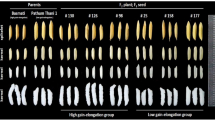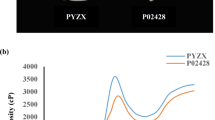Abstract
Key message
This manuscript reports the fine mapping of a novel QTL, qAC2 controlling the low amylose in rice. The action mechanism of the qAC2 is also investigated by the analysis of genetic interactions to Wx a, Wx b, du1, du2 and du3.
Abstract
Amylose content of the rice (Oryza sativa L.) endosperm greatly affects starch properties and eating quality of cooked rice. Seeds of japonica rice cultivar Kuiku162 have low amylose content (AC) and good eating quality. Our analysis revealed a novel QTL, designated as qAC2 that contributed to the low AC of Kuiku162. qAC2 was fine mapped within a 74.9-kb region between two insertion and deletion markers, KID3001 and KID5101, on the long arm of chromosome 2. Seven genes are predicted in this region, but none of them is known to be related to the regulation of AC. The AC of a near-isogenic line (NIL110) carrying qAC2 Kuiku, the Kuiku162 allele of qAC2, in the genetic background of japonica cultivar Itadaki was lower by 1.1 % points than that of Itadaki. The chain length distributions of amylopectin were similar in NIL110 and Itadaki; therefore, the low AC of NIL110 was caused by a decrease in the actual AC, but not by a difference in the amylopectin structure. The interaction analyses revealed that qAC2 Kuiku has epistatic interaction with Wx a. The qAC2 Kuiku has epistatic interactions with two loci, du1 and du2, on Wx b, whereas the genetic effect of qAC2 Kuiku has additive to that of du3 on Wx b. Thus, similar to du1 and du2, qAC2 may have a function related to Wx b mRNA splicing.







Similar content being viewed by others

References
Ando I, Sato H, Aoki N, Suzuki Y, Hirabayashi H, Kuroki M, Shimizu H, Ando T, Takeuchi Y (2010) Genetic analysis of the low-amylose characteristics of rice cultivars Oborozuki and Hokkai-PL9. Breed Sci 60:187–194. doi:10.1270/jsbbs.60.187
He P, Li SG, Qian Q, Ma YQ, Li JZ, Wang WM, Chen Y, Zhu LH (1999) Genetic analysis of rice grain quality. Theor Appl Genet 98:502–508. doi:10.1007/s001220051098
Ikeno S (1914) Über die Bestäubung und die Bastardierung von Reis. Z Pflanzenzücht 2:495–503
Isshiki M, Nakajima M, Satoh H, Shimamoto K (2000) dull: rice mutants with tissue-specific effects on the splicing of the waxy pre-mRNA. Plant J 23:451–460. doi:10.1046/j.1365-313x.2000.00803.x
Isshiki M, Matsuda Y, Tasaki A, Wong HL, Satoh H, Shimamoto K (2008) Du3, a mRNA cap-binding protein gene, regulates amylose content in japonica rice seeds. Plant Biotechnol 25:483–487. doi:10.5511/plantbiotechnology.25.483
Juliano BO (1971) A simplified assay for milled-rice amylose. Cereal Sci Today 16:334–340
Juliano BO (1985) Rice: chemistry and technology. American Association of Cereal Chemists, Minnesota
Juliano BO, Villareal CP (1993) Grain quality evaluation of world rices. IRRI, Philippines
Lander ES, Botstein D (1989) Mapping Mendelian factors underlying quantitative traits using RFLP linkage maps. Genetics 121:185–199
Lander ES, Green P, Abrahamson J, Barlow A, Daley MJ, Lincoln SE, Newburg L (1987) MAPMAKER: an interactive computer package for constructing primary genetic linkage maps of experimental and natural populations. Genomics 1:174–181. doi:10.1016/0888-7543(87)90010-3
Li Z, Wan J, Xia J, Yano M (2003) Mapping of quantitative trait loci controlling physico-chemical properties of rice grains (Oryza sativa L.). Breed Sci 53:209–215. doi:10.1270/jsbbs.53.209
Li J, Zhang W, Wu H, Guo T, Liu X, Wan X, Jin J, Hanh TT, Thoa NT, Chen M, Liu S, Chen L, Liu X, Wang J, Zhai H, Wan J (2011) Fine mapping of stable QTLs related to eating quality in rice. (Oryza sativa L.) by CSSLs harboring small target chromosomal segments. Breed Sci 61:338–346. doi:10.1270/jsbbs.61.338
McCouch SR, Teytelman L, Xu Y, Lobos KB, Clare K, Walton M, Fu B, Maghirang R, Li Z, Xing Y, Zhang Q, Kono I, Yano M, Fjellstrom R, DeClerck G, Schneider D, Cartinhour S, Ware D, Stein L (2002) Development and mapping of 2240 new SSR markers for rice (Oryza sativa L.). DNA Res 9:199–207. doi:10.1093/dnares/9.6.199
Morishima H, Sano Y, Oka H (1992) Evolutionary studies in cultivated rice and its wild relatives. Oxf Surv Evol Biol 8:135–184
Nagamine T, Komae K (1996) Improvement of a method for chain-length distribution analysis of wheat amylopectin. J Chromatogr 732:255–259. doi:10.1016/0021-9673(95)01229-X
Nishi A, Nakamura Y, Tanaka N, Satoh H (2001) Biochemical and genetic analysis of the effects of amylose-extender mutation in rice endosperm. Plant Physiol 127:459–472. doi:10.1104/pp.010127
Preiss J, Sivak MN (1996) Starch synthesis in sinks and sources. In: Zamski E, Schaffer AA (eds) Photoassimilate distribution in plants and crops: source-sink relationships. Marcel Dekker, New York, pp 63–96
Sano Y (1984) Differential regulation of waxy gene expression in rice endosperm. Theor Appl Genet 65:467–473. doi:10.1007/BF00254822
Sano Y, Hirtano H-Y, Nishimura M (1991) Evolutionary significance of differential regulation at the wx locus of rice. Rice Genetics. In: Proceeding of the International Rice Genetics Symposium II. IRRI, Philippines, pp 11–20
Sato H, Suzuki Y, Sakai M, Imbe T (2002) Molecular characterization of Wx-mq, a novel mutant gene for low-amylose content in endosperm of rice (Oryza sativa L.). Breed Sci 52:131–135. doi:10.1270/jsbbs.52.131
Satoh H, Omura T (1981) New endosperm mutations induced by chemical mutagen in rice, Oryza sativa L. Jpn J Breed 31:316–326. doi:10.1270/jsbbs1951.31.316
Satoh H, Omura T (1986) Mutagenesis in rice by treating fertilized egg cells with nitroso compounds. Rice Genetics. In: Proceeding of the International Rice Genetics Symposium. IRRI, Philippines, pp 707–717
Septiningsih EM, Trijatmiko KR, Moeljopawiro S, McCouch SR (2003) Identification of quantitative trait loci for grain quality in an advanced backcross population derived from the Oryza sativa variety IR64 and the wild relative O. rufipogon. Theor Appl Genet 107:1433–1441. doi:10.1007/s00122-003-1376-z
Takeda Y, Hizukuri S (1987) Structures of rice amylopectins with low and high affinities for iodine. Carbohydr Res 168:79–88. doi:10.1016/0008-6215(87)80008-3
Takeuchi Y, Nonoue Y, Ebitani T, Suzuki K, Aoki N, Sato H, Ideta O, Hirabayashi H, Hirayama M, Ohta H, Nemoto H, Kato H, Ando I, Ohtsubo K, Yano M, Imbe T (2007) QTL detection for eating quality including glossiness, stickiness, taste and hardness of cooked rice. Breed Sci 57:231–242. doi:10.1270/jsbbs.57.231
Umemoto T, Terashima K (2002) Activity of granule-bound starch synthase is an important determinant of amylose content in rice endosperm. Funct Plant Biol 29:1121–1124. doi:10.1071/PP01145
Wan XY, Su CC, Shen WB, Zhai HQ, Yasui H, Yoshimura A, Wan JM (2003) Stable expression of QTL for cooking and eating quality (Oryza sativa L.) in CSSLs population. Rice Genet Newsl 20:57–60
Wan XY, Wan JM, Su CC, Wang CM, Shen WB, Li JM, Wang HL, Jiang L, Liu SJ, Chen LM, Yasui H, Yoshimura A (2004) QTL detection for eating quality of cooked rice in a population of chromosome segment substitution lines. Theor Appl Genet 110:71–79. doi:10.1007/s00122-004-1744-3
Webb BD (1980) Rice quality and grades. In: Luh BS (ed) Rice: production and utilization. Avi Publication Company, Conneticut, pp 543–565
Yano M, Okuno K, Satoh H, Omura T (1988) Chromosomal location of genes conditioning low amylose content of endosperm starches in rice, Oryza sativa L. Theor Appl Genet 76:183–189. doi:10.1007/BF00257844
Zeng D, Yan M, Wang Y, Liu X, Qian Q, Li J (2007) Du1, encoding a novel Prp1 protein, regulates starch biosynthesis through affecting the splicing of Wx b pre-mRNAs in rice (Oryza sativa L.). Plant Mol Biol 65:501–509. doi:10.1007/s11103-007-9186-3
Acknowledgments
We thank Dr. T. Kumamaru (Kyushu University), for providing EM2, EM12 and EM23 seeds, and the local independent administrative agency Hokkaido Research Organization for providing Kuiku162 seeds. We thank Y. Yabuki, R. Mikami, and S. Kinoshita for their technical assistance. This work was supported by a Grant from the Ministry of Agriculture, Forestry and Fisheries of Japan (Integrated research project for plant, insect and animal using genome technology, QT2011, DM1001 and DM1002, Genomics for Agricultural Innovation, QTL4010, and Genomics-based Technology for Agricultural Improvement, RBS2011).
Conflict of interest
The authors declare that they have no conflict of internet.
Author information
Authors and Affiliations
Corresponding author
Additional information
Communicated by Yunbi Xu.
Electronic supplementary material
Below is the link to the electronic supplementary material.
122_2014_2432_MOESM1_ESM.docx
Figure S1 Breeding scheme for the development of materials for QTL mapping, high-resolution mapping, NIL evaluation and genetic interaction analysis (DOCX 168 kb)
122_2014_2432_MOESM2_ESM.docx
Figure S2 Frequency distribution of amylose content in 125 BC3F2 plants. White arrow indicates the mean value for Itadaki. Horizontal line under the arrow indicates SD (DOCX 466 kb)
Rights and permissions
About this article
Cite this article
Takemoto-Kuno, Y., Mitsueda, H., Suzuki, K. et al. qAC2, a novel QTL that interacts with Wx and controls the low amylose content in rice (Oryza sativa L.). Theor Appl Genet 128, 563–573 (2015). https://doi.org/10.1007/s00122-014-2432-6
Received:
Accepted:
Published:
Issue Date:
DOI: https://doi.org/10.1007/s00122-014-2432-6



